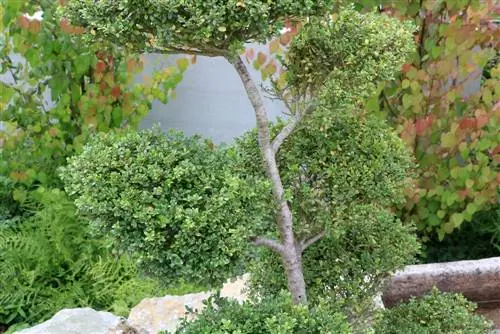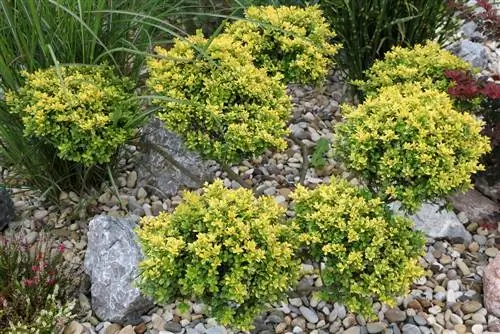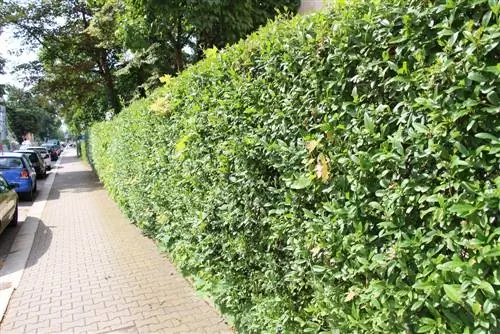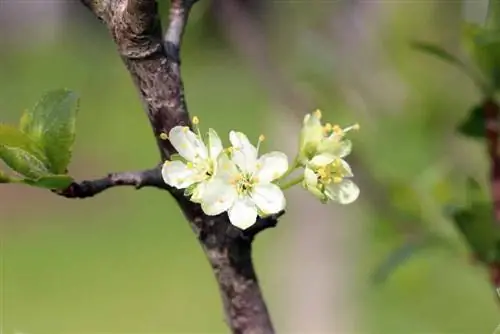- Author admin [email protected].
- Public 2023-12-17 03:39.
- Last modified 2025-06-01 06:48.
The Ilex is found in all climates of the world, but is usually most common in tropical or subtropical regions. About 204 species grow in China and 149 of them are only found in this part of the world. Only the European holly (Ilex aquifolium) is native to Central Europe.
Characteristics of the Ilex
The Ilex shrub reaches heights of between two and 25 meters. The main leaves are large and leathery, deep dark green and shiny. They have a jagged leaf edge and an elliptical shape. While the flowers look rather small and inconspicuous, the red drupes that the holly produces are very attractive. On some varieties these berries remain green, on others brown to black. The plant grows either as an evergreen shrub or as a densely branched tree. As a shrub it reaches heights of up to one meter, and as a tree it can reach heights of up to 15 meters. Interestingly, the leaves change shape and color the higher up the branch they grow on. The higher the leaves grow, the fewer spines they have on their edges. They are also smaller than the deeper leaves and have a more brownish color.
Tip:
Holly trees can live for several hundred years depending on location and location.
Location in the garden and in the great outdoors
In Germany it occurs particularly in the low mountain ranges west of the Rhine, in the Black Forest, in the north and in the foothills of the Alps. Here it mostly grows in gardens or in the wild in beech or spruce forests. The soil should be moist and low in lime. In the cities, the Ilex is also part of parks and public facilities.
- Basically, the Ilex is rather undemanding as long as it has loose and moist soil under its feet.
- It prefers a bright spot in the garden or park, but as a shrub it also feels at home under large trees.
- In such a partially shaded place it should be airy and light.
Since it likes to stand on moist ground in nature, you should take this preference into account, especially if the Ilex is planted in a pot or in a smaller front garden bed. The less soil is available, the more careful attention must be paid to soil moisture. However, since it grows quite slowly, a larger container is right for it. It can stay here for a few years.
Attention
The holly Ilex aquifolium is highly poisonous!
Care for Ilex
One advantage of the Ilex, in addition to the beautiful red berries, is that it requires little care. Once it has grown in its location and feels comfortable there, its owner only needs to pay attention to the soil moisture. The Ilex should also not be planted in a wind corridor, it doesn't particularly like that. If the plant grows in a pot on the balcony or terrace, it must be supplied with water and nutrients like all other potted plants.
- Some complete fertilizer can be used every now and then for possible fertilization.
- Horn shavings can also be very helpful if the earth is no longer so active after years.
- However, since the Ilex requires very few nutrients, over-fertilization is easily resented.

If you pay attention to the pH value of the soil and react accordingly, the Ilex will feel very comfortable. In principle, a layer of bark mulch can retain moisture in the soil for longer. An occasional gift of chopped plants or grass clippings also promotes well-being.
Ilex cut
Ilex branches are particularly valued by us because of the decorative effect of the leaves with the red berries. If the shrub or tree needs to be shortened for other reasons, this is easily possible. It can be shaped into any shape you like without suffering. Pruning, as is done on other plants to promote growth, does not necessarily have to be done. If the Ilex is planted as a hedge or as a privacy screen, it can be cut into the desired shape. However, since it only grows slowly, it takes longer to reach the desired height.
Unlike other plants, the Ilex is best cut in summer. The best time for pruning would be between July and August. If necessary, it would also tolerate pruning at other times without perishing or losing its beautiful appearance.
Possible diseases of the Ilex
There are no diseases or pests that affect the Ilex particularly often or more easily than other plants. The leaf miner fly would be a possible parasite; it leaves light or brown spots on the leaves that are caused by the fly's feeding. Although it leaves unsightly stains, it is otherwise not harmful to the holly. There is no need to fear serious illnesses.
The camellia scale insect could also plague the holly. Woolly white structures - the so-called egg sacs - would then be found on the underside of the leaves. If the infestation gets out of hand, honeydew may form. This type of scale insect is often found on Pfaffenhütchen, ivy, camellia or rhododendron. If these plants are in the immediate vicinity of the Ilex, hiking over is possible.
Propagate Ilex
If holly is to be propagated, it is best to form runners. Propagation by seeds from the berries would be too difficult and time-consuming. Cuttings can be made in August, which also form roots when inserted into the soil. This also takes a while, so the gardener's patience is definitely required.
What you should know about Ilex varieties in brief
- Ilex are very cut-tolerant. This makes them well suited for hedge planting.
- The variety 'Blue Prince' is the ideal hedge plant, dense, beautifully dark green, bears fruit and is impenetrable, otherwise it stings.
- You should be careful with some varieties of Ilex because of their toxicity. For some, the berries and leaves are more or less poisonous.
- Not all Ilex are sufficiently hardy. Before you buy a plant, you should find out carefully whether it is suitable.
There are over 2,000 varieties, so you are spoiled for choice. The most visually beautiful cultivars are often the most sensitive. If you comply with the necessary site conditions (no winter sun, mulched soil) you can try such a variety. Ideal are:
- Ilex aquifolium ‘Silver Queen’
- Ilex aquafolium ‘Ferox Argentea’
- Ilex x altaclerensis 'Golden King'
All three impress with their colorful foliage. Otherwise, the species differ in the different shape, color and size of the leaves. The leaves of Ilex x meserveae 'Blue Princess' are a beautiful dark green, while 'Blue Hollies' have a dark blue appearance. There are very light green and also yellow specimens. There is something for every taste. Also very popular are 'Argenteomarginata' because of its silvery foliage and 'Golden Milkboy/Milkgirl' because of its gold-flecked leaves.
Fruits only occur when female and male specimens are planted together. Ilex x meserveae 'Blue Prince' is particularly suitable. If you only want a single plant, you should choose Ilex aquifolium 'J. C. van Tol' decide. This is monoecious and also produces satisfactory fruit when placed alone.






